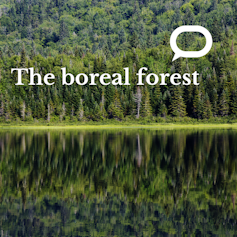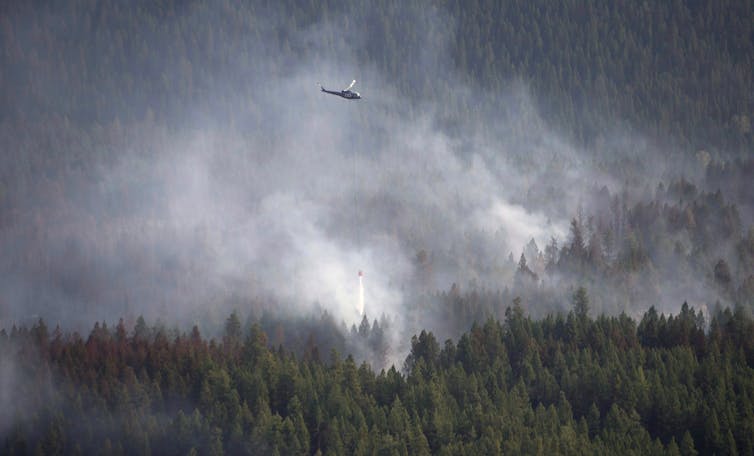“Zombie fires” are fires that ignite in one fire season, smoulder through the winter months under the snow, and re-emerge early in the spring before lightning and human caused ignitions begin in earnest.

This article is part of La Conversation Canada’s series The boreal forest: A thousand secrets, a thousand dangers
La Conversation Canada invites you to take a virtual walk in the heart of the boreal forest. In this series, our experts focus on management and sustainable development issues, natural disturbances, the ecology of terrestrial wildlife and aquatic ecosystems, northern agriculture and the cultural and economic importance of the boreal forest for Indigenous peoples. We hope you have a pleasant — and informative — walk through the forest!
Northern fire managers prefer the term “overwintering fires,” which is more technically precise. It also avoids stoking the pervasive negative perceptions regarding wildfire, which in the boreal is an essential agent of forest renewal and health.
But it is hard to resist using a term with such strong communication messaging. Are zombie fires something to worry about? As a team of scientists who have dedicated our careers to understanding changing boreal fire regimes, we decided to find out for ourselves.
Unusual fire behaviour
Fire behaviour refers to the way a fire burns. This seemingly unusual fire behaviour was previously of limited concern as overwintering fires are hard to detect and, we think, were relatively infrequent. As such, we know very little about these fires or their potential impacts.
However, as rapid climate warming drives larger, longer and more severe wildfire seasons across the boreal biome, overwintering fires are becoming more common, and concerns by fire managers and scientists alike are increasing.
Reignitions from overwintering fires initiate the fire season earlier than usual, adding additional demands to already strained fire crews and firefighting resources.
For example, the exceptionally early and intense fire season this year in Alberta may have been fuelled in part by early ignitions from overwintering fires given the late season burning throughout western Canada last fall.
Clearly, more research is needed to understand exactly how overwintering fires currently or will contribute to these severe fire seasons.
Remote fire study
Last summer, our team visited sites in the southern Northwest Territories that had ignited in 2014, experienced overwintering fire, and reignited in 2015. These were paired with neighbouring sites from the same 2014 fire that had experienced only a single season fire.
This work required an interdisciplinary team consisting of remote-sensing experts who identified and guided us to our sites, soil carbon experts who developed the sampling protocols necessary to quantify differences in soil carbon losses in single-season and overwintering fire locations, and forest ecologists who quantified the impact of overwintering fires on forest structure and composition.
With these locations in hand and tremendous support from our partners in the Government of the Northwest Territories, we collected the first field data on overwintering fires. All potential sites were incredibly remote and could only be accessed by helicopter — our team was able to use one that was on standby for fire duty as it was a relatively quiet fire season.
Read more: As we fight the Alberta and B.C. wildfires, we must also plan for future disasters
Carbon emissions
There are concerns about the potential ecological and carbon impacts of these fires, but we currently have no data. The most socially relevant concern relates to carbon emissions and potential feedbacks to climate warming.
Much of the boreal biome is characterized by deep, peat soils created by cold, poorly drained conditions. These conditions slow decomposition and support the accumulation of plant material, often peat moss or Sphagnum, as thick layers of carbon rich soil sitting atop the underlying parent material. In some places, this can be many meters thick.
Boreal peatlands are thought to store as much as 30 per cent of the Earth’s terrestrial carbon stocks. As such, threats to these regions have the potential to compound already rapid increases in atmospheric carbon dioxide concentrations that underlie global warming.
When these thick, organic soils are dry, they can support the deep and sustained smouldering necessary for overwintering behaviour. Scientists expect that these peatland environments will be home to most overwintering fires.
Wildfires are also threatening the resilience of boreal forests, with deeper burning and more frequent fires leading to forest compositional changes, and in some cases the conversion of forest to non-forested land covers.
Failure to renew
The second major concern relates to the forest recovery outcomes in forest stands that experience overwintering fires, which in some cases burn twice in as many years. We expect that zombie fires will lead more commonly to regeneration failure — conversion of forest to non-forest — for three main reasons.
First, the continued or repeated heating of tree seeds on site could lead to reduced or absent seed sources to support tree regeneration.
Second, heating or combustion of belowground rooting structures (called rhizomes) that support rapid resprouting post-fire could slow the rate of ground vegetation recovery or completely alter the species that regenerate in these areas.
Finally, the continued smouldering of peat soil would lead to deeper burning which profoundly alters the seedbed conditions with implications for forest regeneration processes.

Changes in forest type or failure for forests to recover affects wildlife habitat availability among other impacts, an issue of increasing concern, particularly in the context of declining caribou populations across North America.
Remote sensing advances
These are all predictions, however. No direct measures existed from overwintering fires until the summer of 2022, as these fires are hard to detect and access and previously of limited concern to managers.
However, advances in space-borne remote sensing have allowed the detection of early spring reignitions, which when combined with information on fire perimeters from the previous year, support accurate detection and mapping of overwintering fires that reignite.
Our team took advantage of these tools to identify the locations of overwintering fire sites that reignited in 2015 following the record breaking 2014 fire season in the Northwest Territories.
Our work will shed light on where and how these fires are supported in the boreal landscape. It will also lead to important insights into carbon losses from this fascinating — although poorly understood — fire behaviour. These include the potential for legacy carbon loss and altered forest regeneration outcomes, which have implications for future fire regimes and the health of the boreal forest.


